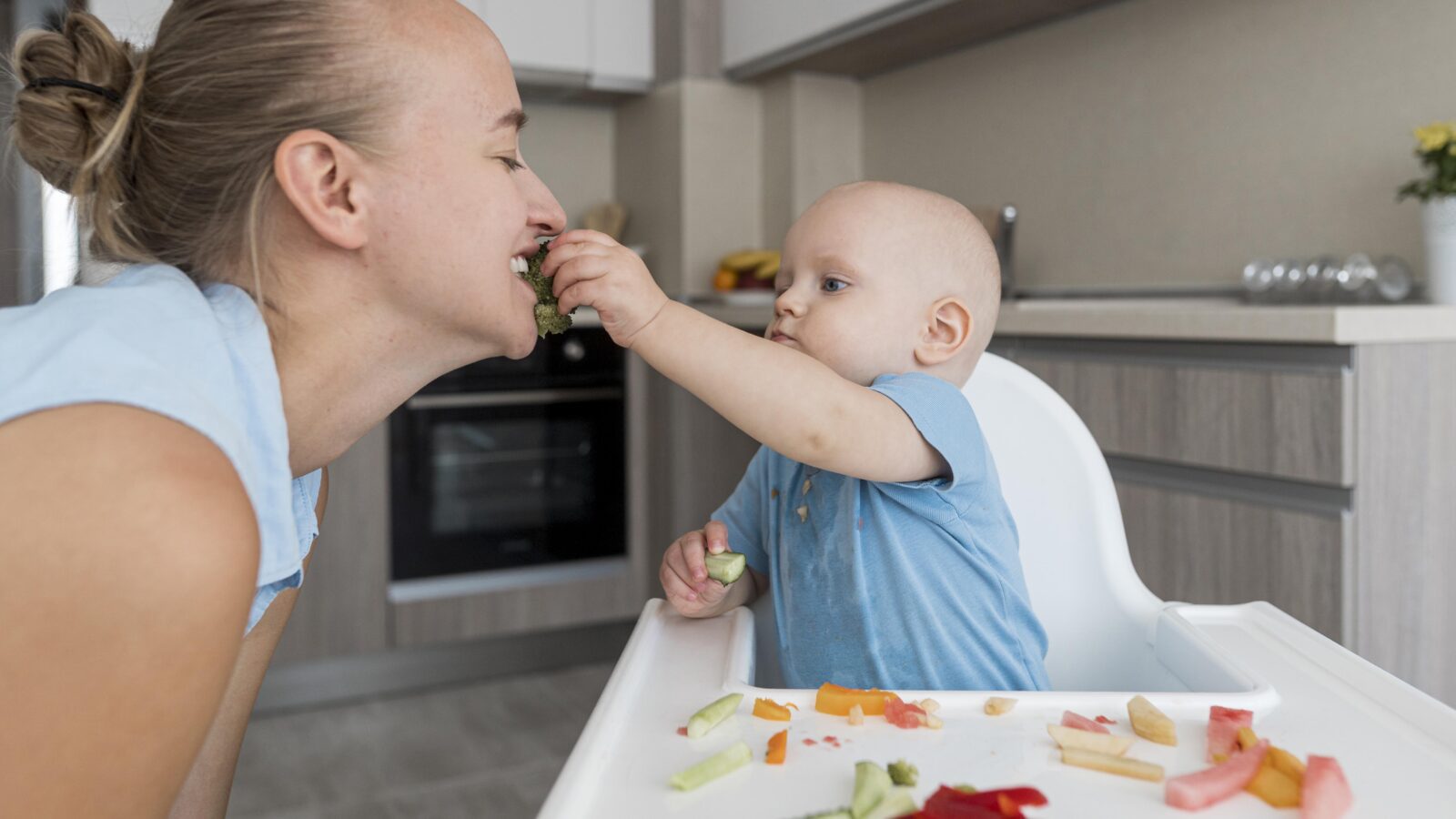If you’re thinking about baby-led weaning (BLW), you’re not alone. Millions of families are turning to this hands-on, confidence-building method to introduce solids in a way that supports development—and makes mealtimes less stressful. Whether you’re just starting to research or ready to dive in, this guide covers everything you need to know about BLW, including expert insights, a food guide, safety tips, and signs of readiness.
What is Baby-Led Weaning (BLW)?
Baby-led weaning skips spoon-fed purees and puts babies in the driver’s seat—literally. Instead of being fed, babies begin exploring real, appropriately sized foods on their own (usually around 6 months of age). It encourages independence, curiosity, motor skill development, and healthy eating habits from the start.
Why More Parents are Choosing BLW
It’s easy to see why baby-led weaning is gaining popularity with modern parents:
✅ Saves Time & Money
No need to buy separate jars, pouches, or prep double meals. Babies eat (safe versions of) what you do.
👨👩👧 Encourages Social Eating
Babies join family mealtimes early and learn by watching others. Studies show they’re more likely to eat well during family meals (Brown & Lee, 2011).
🥑 Promotes Food Variety
From avocado to soft carrots, BLW introduces a range of textures and flavors early, which can help reduce picky eating later.
🧠 Boosts Motor Skills & Self-Regulation
Self-feeding builds hand-eye coordination, chewing skills, and body awareness around hunger and fullness (Rapley et al., 2020).
But Here’s What Really Matters…
According to pediatric feeding experts, the best approach to solids is the one that works best for your baby—and your family. Whether you start with BLW, spoon-feeding, or a mix of both, the most important things are:
- Start solids around 6 months
- Introduce a variety of textures by 9 months
- Focus on safe, responsive, developmentally appropriate feeding
BLW can support motor skills and food exploration, but those same milestones can also be reached through responsive spoon-feeding. Using preloaded spoons, dipping teethers in purees, and encouraging self-feeding alongside mashed foods are great ways to combine the best of both worlds.
💡 If your baby isn’t bringing food to their mouth or is struggling to progress, pause, reassess, and consider a new approach—that’s perfectly okay.
Expert Insight: Responsive Feeding Over Rules
“With BLW, it’s very important that the baby is ready—but also that the caregivers are ready. If they’re nervous or stressed about mealtimes, it may be more beneficial to start with purees and progress from there, rather than start with BLW and create fear around feeding.”
— Liz Koren, OTR/L, SWC
Pediatric Occupational Therapist & Director, Pure Pediatric Therapy
Responsive feeding—where the caregiver follows baby’s cues and keeps mealtimes relaxed—has been shown to support long-term health outcomes. As research by Black & Aboud (2011) notes:
“Early feeding interactions shape long-term food preferences and self-regulation.”
And one key recommendation? Introduce solids by 7 months and offer a range of textures to support oral-motor development. Delayed introduction can lead to increased pickiness or feeding challenges later on.
Is Your Baby Ready for BLW?
The American Academy of Pediatrics (AAP) recommends starting solids around 6 months.
As of 2025, nearly 1 in 3 U.S. parents use baby-led weaning—up from 18% in 2018 (CDC/NCHS).
Look for these signs of readiness:
- ⚠️ ✅ Sits up with little or no support
- ✅ Has strong head and neck control
- ✅ Reaches for food or utensils
- ✅ Watches others eat with interest
First Foods for Baby-Led Weaning
Here’s a quick-reference guide to help you choose safe, nutrient-rich first foods:Important: Never offer honey to babies under 1 year old due to the risk of infant botulism.
📌 Pro Tip: Print or save this list for your next grocery trip!
| Category | BLW-Friendly Options | Avoid These |
| Fruits | Banana, pear, avocado, kiwi, mango, applesauce, soft-cut strawberries | Whole grapes, uncut berries |
| Veggies | Steamed carrots, sweet potatoes, squash, broccoli florets | Raw carrots, celery |
| Proteins | Shredded chicken, tofu, scrambled eggs, soft cheese, Greek yogurt | Tough meats, high-mercury fish |
| Grains | Oatmeal, toast strips with nut butter, rice cakes | Hard crackers, choking-risk cereals |
Navigating Allergens: What’s You Should Know
Research now supports early, consistent introduction of allergens to help prevent food allergies. The most common allergens include:
- 🥚 Eggs
- 🧀 Dairy
- 🥜 Peanuts (only in thin, smooth form—never whole or chunky)
The AAP and the LEAP study recommend introducing allergens around 6 months, based on your baby’s readiness and ability to manage the texture safely.
What to Watch For:
Look out for symptoms such as:
- Rash
- Hives
- Swelling
- Vomiting
These reactions typically occur within minutes to a few hours after eating, but they can also be delayed or triggered by larger amounts.
🩺 If you notice symptoms:
Stop offering the food and contact your pediatrician. For severe reactions like difficulty breathing or facial swelling, call emergency services immediately.
Safety First: Gagging vs. Choking
Before you start solids, it’s essential to understand the difference between gagging and choking—they’re not the same.
- Gagging is common and part of the learning process. It’s usually loud and productive—think coughing, retching, or food being pushed forward.
- Choking is silent and dangerous. A choking baby may be unable to cry, cough, or breathe.
🎥 Not sure what to expect? Watching a few BLW safety videos can be incredibly helpful.
Watch These Before You Begin:
- Gagging vs. Choking – Safe Beginnings First Aid
- BLW Gagging Explained – Feeding Littles
- Real Baby Gag Reflex Example – Solid Starts
- Choking First Aid for Babies – Tiny Hearts Education
Once you feel confident spotting the difference between gagging and choking, read on to make sure your setup is safe and baby-ready.
BLW Safety Checklist
Use this quick checklist to start solids with confidence:
- Baby is seated upright in a high chair and fully supervised
- Foods are soft, mashable, and cut into age-appropriate shapes
- Avoid high-risk choking hazards: whole nuts, raw carrots, grapes, hot dogs, popcorn
- Caregivers have taken or reviewed pediatric CPR
💡 Pro Tip: Download our [Baby-Led Weaning Safety Checklist PDF] and tape it to your fridge for easy reference.
Frequently Asked Questions
Q: Can I combine BLW with spoon-feeding?
Yes! Many families take a hybrid approach—offering both purees and BLW-friendly foods to promote texture progression and self-feeding confidence.
Q: What if my baby isn’t eating much?
Breast milk or formula remains the main source of nutrition in the first year. If your baby isn’t progressing in food exposure, a feeding therapist can help.
Q: Is it really that messy?
Absolutely—and that’s a good thing! Mess = learning. Let your baby explore freely.
📸 Share your BLW journey on Instagram and tag @NewMomSchool to be featured!
Final Thoughts
There’s no one-size-fits-all approach to starting solids. Whether you go full BLW, spoon-feed, or do a little of both—what matters most is that your baby is safe, supported, and curious.
Follow your baby’s cues. Stay calm and responsive. And trust that you’re doing a great job.
🙌 Special Thanks to Our Expert Contributor:
Liz Koren, OTR/L, SWC
Pediatric Occupational Therapist
Director, Pure Pediatric Therapy
We’re so grateful to Liz for sharing her clinical insight and supporting families through one of the most exciting (and sometimes overwhelming) phases of early parenting.
Looking for More Support?
Our New Mom School classes are designed to guide you through the feeding journey (and beyond) with expert-backed education, real community, and zero judgment.

